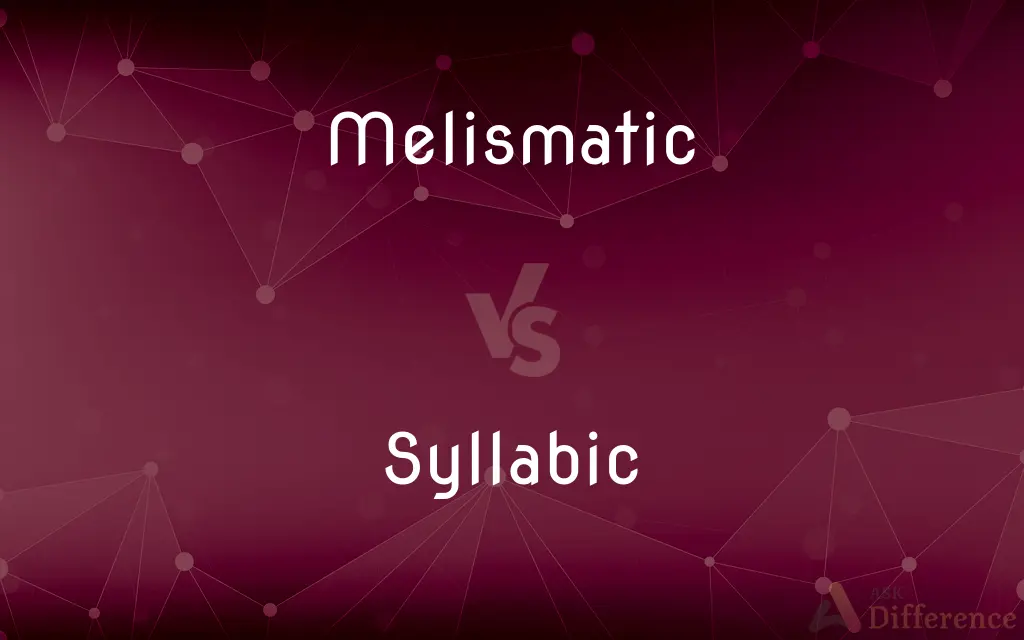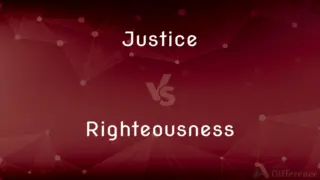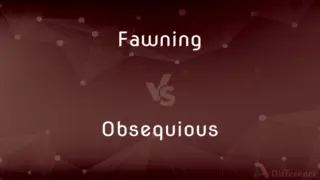Melismatic vs. Syllabic — What's the Difference?
By Fiza Rafique & Urooj Arif — Updated on March 26, 2024
Melismatic singing involves stretching a single syllable over multiple notes, whereas syllabic singing assigns one note per syllable.

Difference Between Melismatic and Syllabic
Table of Contents
ADVERTISEMENT
Key Differences
Melismatic singing is a vocal style characterized by elongating a single syllable of text across several musical notes. It's often used to emphasize emotional expression or showcase the vocalist's skill and is prevalent in genres like gospel, opera, and traditional Middle Eastern music. On the other hand, syllabic singing assigns a single note to each syllable of the lyrics, making it straightforward and more closely mirroring spoken rhythm. This style is common in folk music, pop, and musical theater, where clarity of the text is paramount.
In melismatic singing, the focus is on the musicality and expressiveness of the voice, often at the expense of text clarity. The melismas can range from simple two-note figures to complex, elaborate runs spanning several measures. In contrast, syllabic singing prioritizes the lyrics' intelligibility and directness, with the melody directly following the natural rhythm and cadence of the words.
The choice between melismatic and syllabic singing often depends on the musical genre, cultural traditions, and the specific emotional or narrative context of the piece. While melismatic singing can add layers of complexity and emotional depth, syllabic singing offers a more straightforward, text-driven approach.
Melismatic passages require a high level of vocal control and technique, as they often involve intricate runs, leaps, and sustained notes. Syllabic singing, while potentially less technically demanding, requires a strong sense of rhythm and diction to effectively communicate the lyrics.
Both styles have their place in music education and performance, teaching different aspects of vocal technique and musical expression. While melismatic singing explores the extent of vocal agility and musicality, syllabic singing focuses on clear articulation and the expressive potential of the text.
ADVERTISEMENT
Comparison Chart
Definition
Stretching a single syllable over multiple notes.
Assigning one note per syllable.
Focus
Musicality and expressiveness of voice.
Clarity and directness of text.
Complexity
Can be highly complex, with elaborate runs.
Straightforward, mirroring spoken rhythm.
Vocal Technique
Requires high level of vocal control.
Demands strong sense of rhythm and diction.
Common in Genres
Gospel, opera, traditional Middle Eastern.
Folk music, pop, musical theater.
Compare with Definitions
Melismatic
Used to enhance emotional expression in music.
Traditional gospel music employs melismatic singing for spiritual intensity.
Syllabic
Suited for text-driven musical expressions.
Musical theater often employs syllabic singing to convey narrative clearly.
Melismatic
Singing style where a single syllable spans multiple notes.
The national anthem often features melismatic singing on the word free.
Syllabic
Accessible and straightforward vocal technique.
Children's songs are typically syllabic to aid in learning.
Melismatic
Characterized by elaborate vocal runs and ornamentation.
Mariah Carey's music showcases extensive use of melismas.
Syllabic
Singing style where each syllable corresponds to a single note.
Most modern pop songs use a syllabic approach for clarity.
Melismatic
Often found in religious and traditional music.
Gregorian chants are notable for their melismatic vocal lines.
Syllabic
Prioritizes lyric intelligibility and rhythmic precision.
Folk music traditions emphasize syllabic singing for storytelling.
Melismatic
Requires advanced vocal agility and control.
Opera singers train extensively to master melismatic passages.
Syllabic
Reflects natural speech patterns in music.
Rap music, though spoken, adheres to a syllabic rhythm in its delivery.
Melismatic
A passage of multiple notes sung to one syllable of text, as in Gregorian chant.
Syllabic
Of, relating to, or consisting of a syllable or syllables.
Melismatic
(music) Of, relating to, or being a melisma; the style of singing several notes to one syllable of text.
Syllabic
Pronounced with every syllable distinct.
Syllabic
(Linguistics) Designating a sound that is or can be the most sonorant segment of a syllable, as a vowel or a resonant. In the word riddle (rĭdl), the two syllabic sounds are the (ĭ) and the (l).
Syllabic
Of or being a form of verse based on the number of syllables in a line rather than on the arrangement of accents or quantities.
Syllabic
A syllabic sound.
Syllabic
Of, relating to, or consisting of a syllable or syllables.
Syllabic
Pronounced with every syllable distinct.
Syllabic
(linguistics) Designating a sound that is or can be the most sonorant segment of a syllable, as a vowel or a resonant. In the word riddle ([ɹɪdl̩]), the two syllabic sounds are [ɪ] and [l̩].
Syllabic
Of, or being a form of verse, based on the number of syllables in a line rather than on the arrangement of accents or quantities.
Syllabic
(linguistics) A syllabic sound.
Syllabic
Of or pertaining to a syllable or syllables; as, syllabic accent.
Syllabic
Consisting of a syllable or syllables; as, a syllabic augment.
Syllabic
Of or relating to syllables;
Syllabic accent
Syllabic characters each represent a syllable
Syllabic
Consisting of or using a syllabary or syllabic characters;
Eskimos of the eastern Arctic have a system of syllabic writing
Syllabic
(of verse) having a metric system based on relative duration of syllables;
In typical Greek and Latin verse of the classical period the rhymic system is based on some arrangement of long and short elements
Syllabic
Consisting of a syllable or syllables; constituting a syllable or the nucleus of a syllable; consisting of a consonant sound not accompanied in the same syllable by a vowel sound or consisting of a vowel sound dominating the other vowel sounds in a syllable (as being the first vowel in a falling diphthong);
The syllabic `l' in `riddle' or the syllabic `n' in `botany' when it is pronounced `bot-n-y'
The syllabic `o' in `oi'
Syllabic
Of liquids and nasals
Common Curiosities
Can a song contain both melismatic and syllabic singing?
Yes, many songs incorporate both styles to vary expression and highlight different aspects of the music and text.
Why is melismatic singing used?
It's used to showcase vocal skill, add emotional depth, and enhance musical expression.
What is syllabic singing?
Syllabic singing assigns one note to each syllable, emphasizing clarity and directness of the lyrics.
Which is more complex, melismatic or syllabic singing?
Melismatic singing is typically more complex due to its elaborate runs and vocal ornamentation.
How does syllabic singing affect a song's clarity?
It makes the lyrics more intelligible and straightforward, closely mirroring the rhythm of natural speech.
Is melismatic singing harder to learn than syllabic singing?
Yes, it generally requires more advanced vocal technique and control.
What genres typically feature melismatic singing?
Gospel, opera, and traditional Middle Eastern music often feature melismatic passages.
How does syllabic singing benefit storytelling in music?
It ensures that each word is clear and distinct, supporting narrative clarity in genres like folk music and musical theater.
What is melismatic singing?
Melismatic singing involves stretching a single syllable of text over multiple musical notes, often used for emotional expression.
What skills are needed for effective melismatic singing?
Vocal agility, control, and the ability to navigate complex musical runs and leaps.
How do performers decide between melismatic and syllabic singing?
The choice often depends on the song's genre, emotional context, and the narrative being conveyed.
Can syllabic singing be expressive?
Yes, it can be highly expressive, especially in conveying the lyrics' direct emotional or narrative content.
How do melismatic and syllabic singing styles influence vocal training?
They teach different aspects of vocal technique and musical expression, from technical agility to clear articulation and rhythmic precision.
Are there musical traditions that prefer melismatic singing?
Yes, many religious and traditional music forms, such as Gregorian chant, prioritize melismatic singing for its spiritual and emotional impact.
Why might a composer choose syllabic over melismatic singing?
To prioritize text clarity, especially in narrative-driven pieces like musical theater.
Share Your Discovery

Previous Comparison
Justice vs. Righteousness
Next Comparison
Fawning vs. ObsequiousAuthor Spotlight
Written by
Fiza RafiqueFiza Rafique is a skilled content writer at AskDifference.com, where she meticulously refines and enhances written pieces. Drawing from her vast editorial expertise, Fiza ensures clarity, accuracy, and precision in every article. Passionate about language, she continually seeks to elevate the quality of content for readers worldwide.
Co-written by
Urooj ArifUrooj is a skilled content writer at Ask Difference, known for her exceptional ability to simplify complex topics into engaging and informative content. With a passion for research and a flair for clear, concise writing, she consistently delivers articles that resonate with our diverse audience.














































